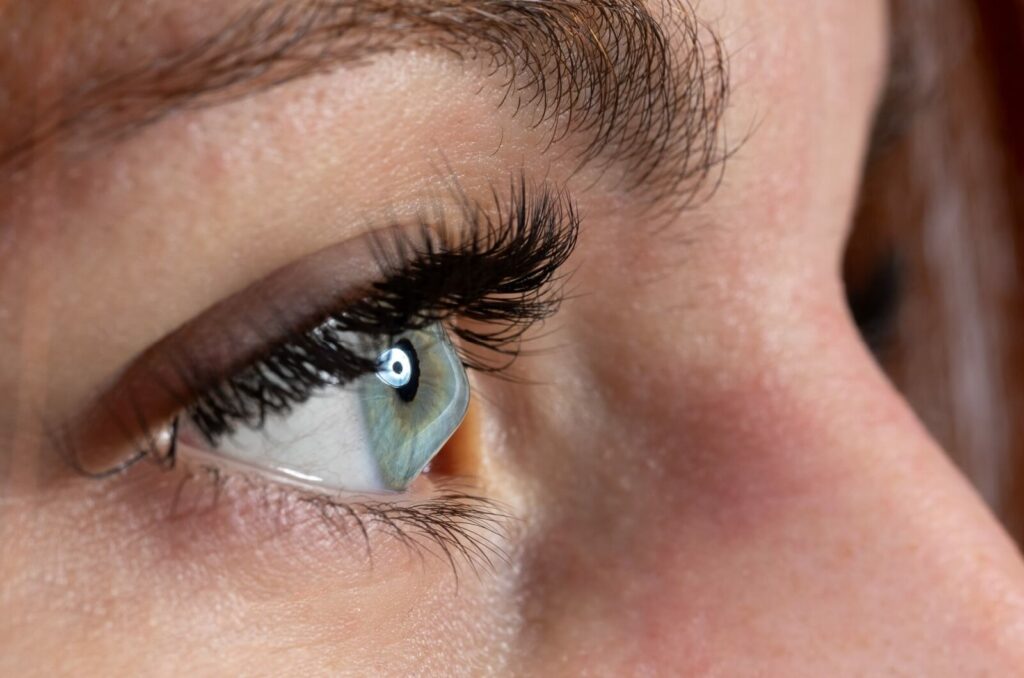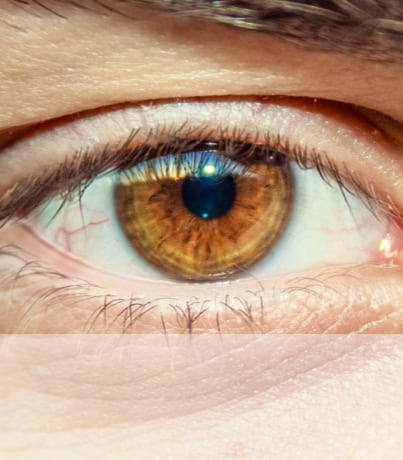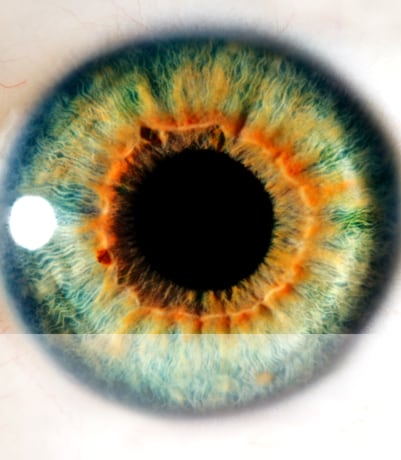Keratoconus is an eye disease affecting the eye’s cornea and, ultimately, vision. Keratoconus can be partly genetic and partly epigenetic, meaning that it’s hereditary, though environmental and behavioral factors also play a role.
Regular comprehensive eye exams can help monitor eye health, detect early signs of vision problems, and help monitor vision changes so they don’t worsen and affect your sight.
What Is Keratoconus?
Keratoconus is a progressive eye disease involving the clear outer layer of the eye or the cornea. Collagen, found in the middle layer or the thickest part of the cornea, keeps the cornea strong and flexible and helps maintain a regular, round shape. A healthy cornea helps light focus onto the retina (the light-sensitive tissue at the back of the eye) to form a clear image.
In keratoconus, the cornea thins and bulges into an irregular cone shape. This alteration affects vision and can result in vision loss. Keratoconus typically affects both eyes, however, one eye may be more affected than the other.
Common symptoms of keratoconus include:
- Blurred or distorted vision
- Sensitivity to bright light
- Worsening vision
- Frequent changes in prescription glasses or contact lenses
- Increased nearsightedness
- Glare and halos around lights
- Difficulty seeing at night
Living with keratoconus can be a daily struggle. The distorted vision that it causes can make reading, driving, and even recognizing faces difficult. Many patients experience eye strain, eye irritation, and headaches from eye pain due to the constant effort to see clearly.
Is Keratoconus Genetic?
Research suggests that genetics play a significant role in the development of keratoconus. Studies have identified several genes associated with the condition, indicating that it can run in families.
However, keratoconus is likely influenced by genetic and environmental factors. Epigenetic factors associated with keratoconus or factors that can increase your risk include:
- Eye rubbing can lead to keratoconus and is a risk factor for disease progression.
- Contact lens trauma.
- Exposure to ultraviolet (UV) radiation.
- Chronic eye inflammation from allergies or irritants can destroy corneal tissue and lead to keratoconus.
- Age, as keratoconus develops in the teenage years.
Keratoconus does not follow a straightforward inheritance pattern like some genetic disorders. Instead, having a family member with keratoconus increases your risk, but does not guarantee you will develop it. If there is a family history of keratoconus, it’s essential to monitor your eye health regularly.
Diagnosing Keratoconus
Early diagnosis of keratoconus is crucial for managing the condition effectively. The sooner it’s detected, the better the chances of slowing its progression and preserving vision. Regular eye exams can help catch the signs early on, especially if you have a family history of the disease. Tests to diagnose keratoconus can include the following:
- Corneal topography: Computer images help create a map of the cornea’s curvature to diagnose keratoconus and follow its progression.
- Slit-lamp exam: This exam looks at abnormalities in the cornea’s middle and outer layers.
- Pachymetry: Measures the cornea’s thinness.
Treatment & Management

While there is no cure for keratoconus, efforts can be made towards vision correction. Several treatments can help manage the symptoms and slow progression based on the stage of keratoconus.
In the earlier stages, treatment includes glasses to address refractive errors such as nearsightedness and astigmatism. However, with progression, glasses may not provide vision clarity. In this case, contact lenses are recommended.
Traditional contact lenses can rotate and cause discomfort and fluctuating vision because of the cornea’s irregular curvature. For these reasons, hard or scleral lenses are more stable for keratoconus. Scleral lenses have a larger diameter that sits on the whites or sclera and vaults over the cornea to create a smooth optical surface.
Other treatments for keratoconus can include:
- Corneal collagen cross-linking: This procedure strengthens the cornea by creating new collagen bonds, helping to halt the progression of keratoconus.
- Surgery: In severe cases, corneal transplant surgery may be necessary to replace the damaged cornea with a healthy donor cornea.
Lifestyle Adjustments & Daily Management of Keratoconus
Living with keratoconus requires some lifestyle adjustments. Protecting your eyes from UV rays and avoiding eye rubbing can prevent further damage. Healthy habits such as maintaining a healthy diet rich in antioxidants can help manage symptoms and support eye health.
Use prescription glasses or contact lenses specifically designed for keratoconus. Regular follow-ups with your eye doctor are vital to monitor the condition and adjust treatments.
Personalized Treatment for Keratoconus
Keratoconus may be challenging, but understanding its genetic factors, symptoms, and treatment options can empower you to manage it effectively. Regular eye exams and early diagnosis are vital, especially if you have a family history of the condition.
While you can’t tell how quickly keratoconus progresses or if it will progress, the right treatment and lifestyle adjustments can preserve your vision.
If you suspect that you or a loved one has keratoconus, book an appointment with Bettner Vision for more information and personalized care and treatment.








